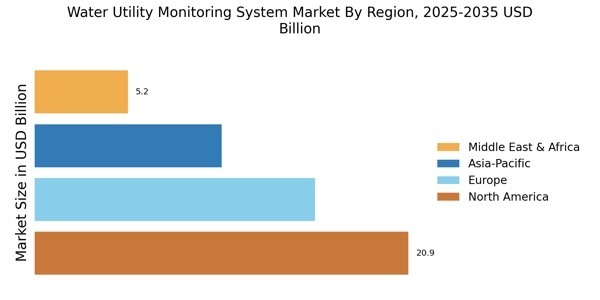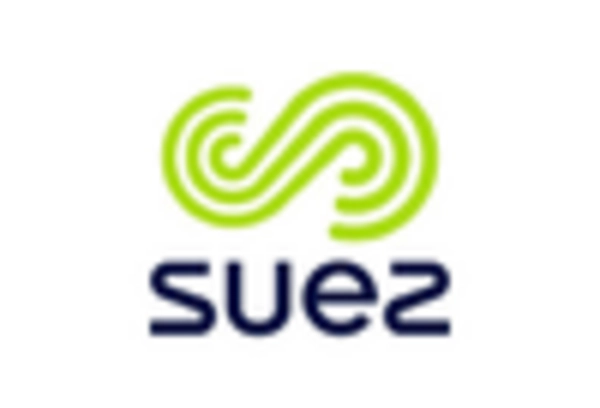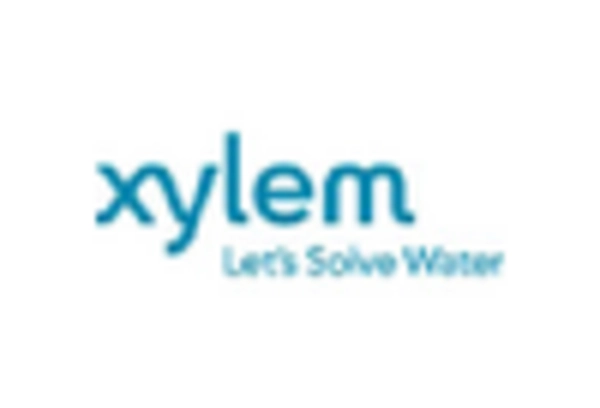Focus on Reducing Operational Costs
The focus on reducing operational costs is a critical driver for the Water Utility Monitoring System Market. Water utilities are under constant pressure to manage their budgets effectively while maintaining service quality. Implementing advanced monitoring systems can lead to significant cost savings by minimizing water loss, optimizing maintenance schedules, and improving resource allocation. Studies indicate that utilities can achieve up to 25% reduction in operational costs through the adoption of smart monitoring technologies. This financial incentive is driving the Water Utility Monitoring System Market towards innovative solutions that enhance efficiency and reduce expenditures, ultimately benefiting both utilities and consumers.
Technological Advancements in IoT and AI
Technological advancements in Internet of Things (IoT) and Artificial Intelligence (AI) are significantly influencing the Water Utility Monitoring System Market. These technologies enable real-time data collection and analysis, facilitating proactive decision-making in water management. The integration of IoT devices allows for continuous monitoring of water quality and flow, while AI algorithms can predict demand patterns and detect anomalies. As a result, utilities can enhance their operational efficiency and reduce costs. The market for IoT in water management is expected to grow at a compound annual growth rate of over 20% in the coming years, indicating a robust shift towards smart water management solutions within the Water Utility Monitoring System Market.
Growing Awareness of Water Scarcity Issues
Growing awareness of water scarcity issues is increasingly influencing the Water Utility Monitoring System Market. As communities face the realities of dwindling water supplies, there is a heightened emphasis on sustainable water management practices. This awareness drives demand for monitoring systems that can provide insights into water usage patterns and identify areas for conservation. The market is witnessing a shift towards solutions that not only monitor but also promote water-saving initiatives. Projections suggest that the Water Utility Monitoring System Market could expand by 18% over the next five years, as stakeholders recognize the importance of addressing water scarcity through effective monitoring and management strategies.
Rising Demand for Efficient Water Management
The increasing demand for efficient water management solutions is a primary driver for the Water Utility Monitoring System Market. As urban populations grow, the pressure on water resources intensifies, necessitating advanced monitoring systems to optimize water distribution and reduce wastage. According to recent estimates, water utilities are projected to face a 30% increase in demand by 2030. This trend compels utilities to adopt innovative technologies that enhance operational efficiency and ensure sustainable water supply. The Water Utility Monitoring System Market is thus witnessing a surge in investments aimed at developing smart solutions that can effectively manage water resources, thereby addressing both supply and demand challenges.
Increasing Regulatory Pressure for Water Quality
Increasing regulatory pressure for water quality and environmental sustainability is a significant driver for the Water Utility Monitoring System Market. Governments and regulatory bodies are implementing stringent standards to ensure safe drinking water and protect aquatic ecosystems. This regulatory landscape compels water utilities to invest in advanced monitoring systems that can provide accurate data on water quality parameters. The market is responding to these demands, with a projected growth rate of approximately 15% annually as utilities seek compliance with regulations. Consequently, the Water Utility Monitoring System Market is evolving to incorporate technologies that facilitate real-time monitoring and reporting, ensuring adherence to regulatory requirements.


















Leave a Comment